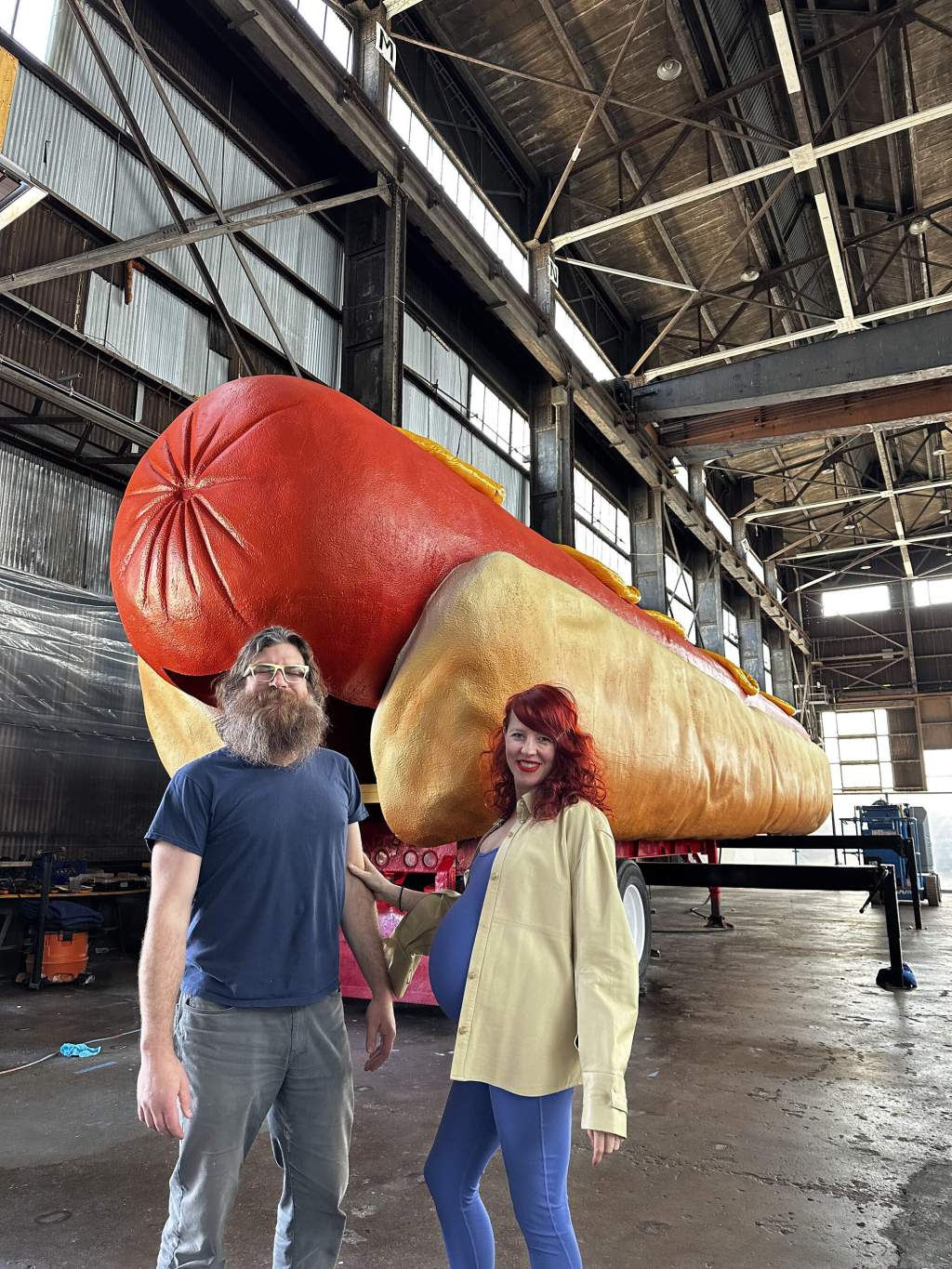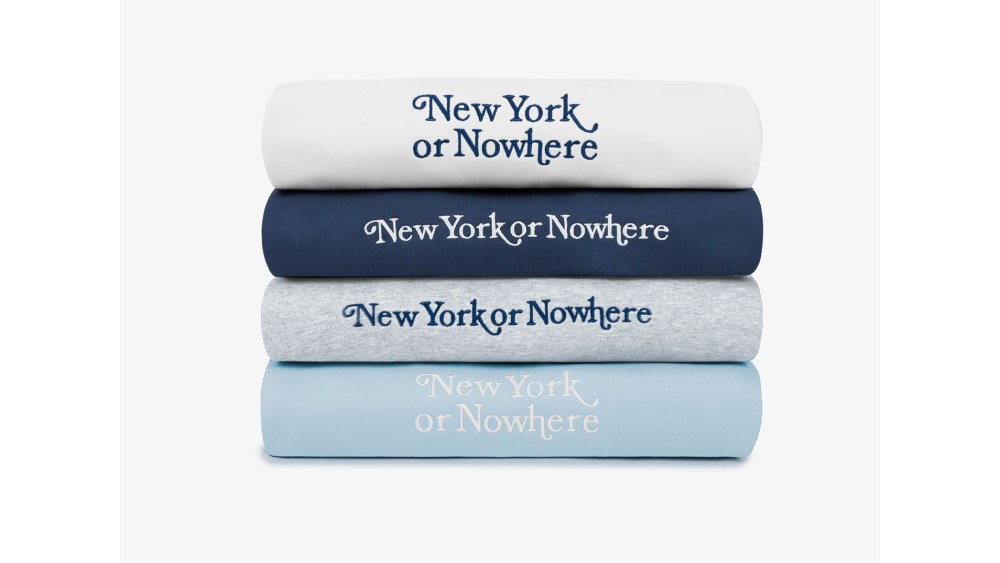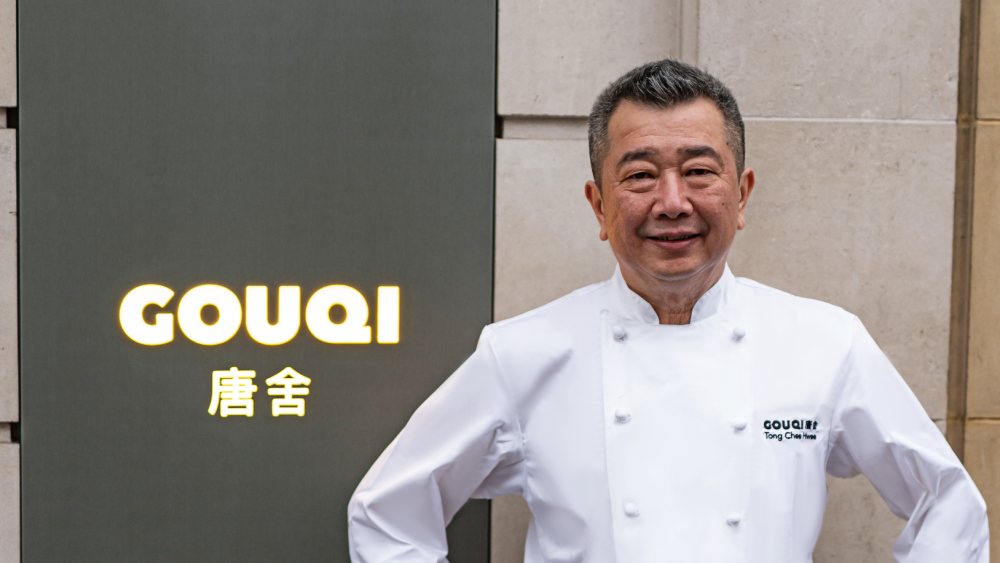Thousands of pedestrians, tourists and drivers near Times Square will be doing a double take — dismayed by the 65-foot hot dog sculpture.
That bewilderment will only increase at noontime, when “Hot Dog in the City” lifts skyward and shoots confetti into the air. Why would anyone create such a spectacle and who would have the imagination to craft it? The Brooklyn-based artistic duo Jen Catron and Paul Outlaw dreamt up the creation, which will be on view through June 13 thanks to Times Square Arts.
Located on Duffy Square at West 46th Street and Seventh Avenue, the super-sized mustard-topped frankfurter is sure to stop people in their tracks. But the jumbo version of the backyard cookout staple is meant to be a critique of capitalism, consumption, excess and class.
During a joint interview last week, the artists said they felt the Times Square hot dog personified an iconic New York City moment and the history of the hot dog — having been brought Stateside by central European immigrants in the 1800s — echoed themes beneath their work. In addition to being symbolic of American culture — think Fourth of July cookouts and baseball games — Catron said, “It was brought to the U.S. by immigrants; Americans then trashed up, pulverized, overly processed it and created a super cheap version through the meatpacking industry so that it could be given to the masses after being heavily marketed. It’s a really great example of American capitalism at work,” adding that questionable labor and production practices are tied to the industry.
“The more we thought about it, the more the hot dog is the perfect representation of America, society and human beings at large — it represents the good, the bad and the not so pretty,” Outlaw said.
After six months of planning, three months were spent building the sculpture in the Brooklyn Navy Yard. The duo’s work has been shown at the Brooklyn Museum and the Museum of Contemporary Art Detroit, and food inspires their artistic practice. “Food is sort of the universal language. Everyone understands and recognizes food. It brings back memories and reminds people of different points and times in their lives. It’s really an excellent entryway into a work of art,” said Outlaw.

Built on the back of a semi-trailer, the 65-foot sculpture is 13.5 feet tall and has a hydraulic mechanism so that it can be raised to shoot confetti into the air. That celebratory effect is meant to be reminiscent of a ticker-tape parade, the annual New Year’a Eve ball drop in Times Square or a Wall Street-esque windfall with a flurry of bills after the closing bell, or gender-reveal parties. The sculpture was built to be transportable and the artists are speaking with museums and cultural institutions for future installations after the six-week residency wraps up.

With 100-plus retailers including many chain stores and an estimated 360,000 estimated daily visitors, Times Square — “the capital of capitalism” — amplifies the messages of the artists, who suggested the origins of the hot dog and what today makes it almost the perfect American capitalism story in good ways and in bad ways. Outlaw said, “It’s very much a corporate mass-produced conglomerate of mysterious meats that is produced in mass quantities by lower working-class meatpacking industry workers. But also that’s being done at the behest of the largest corporations in corporate America and then is mass-marketed into something that it’s not.” The marketing of the hot dog has been done to great success — everyone thinks of it as summertime food, a must for Fourth of July barbecues. Catron noted how “hot dog diplomacy” has been ”intertwined in our politics” (including when King George VI visited the U.S. in 1939 to meet with Franklin Delano Roosevelt and was served hot dogs).
Catron and Outlaw agreed that the installation’s setting mirrors some of their messages, since some of the nearby retailers have allegedly taken advantage of low-income workers and mass-produced clothing to the degree of harming the environment. Outlaw said, “Absolutely. [With] all of our biggest and best corporations in America and in the world, you’d be hard-pressed to find one that doesn’t have some type of negative plot line that goes along with its success. This is a reflection of those corporate norms, practices and ideals that we accept and allow to happen as part of our system.”
Humanizing labor was a priority for the artists, who teamed up with the Street Vendor Project, a 2,900-member organization to create a video series highlighting the “heart-wrenching back stories” and successes of some of the area’s street vendors. “Their stories are a real integral part to this entire project. We’re proud to be presenting some of them,” Catron said.
Outlaw added, “It’s remarkable how hard we make it for some of these street vendors just to scrape together a small living.”

The pair first teamed up 14 years ago, working together in grad school at Cranbrook Academy Art School, where famed talents like Florence Knoll, Nick Cave, Duane Hansen and Jack Lenor Larsen hailed. Their working and personal relationship “kept blossoming” to the point, where “we’re very much collaborators and partners in the studio and in life,” Outlaw said. “We’re not even sure whose idea it is anymore because everything very much works in symphony.”
Having had a large food truck at one point, Catron and Outlaw understand the trials that street vendors face trying to secure permits and avoid penalties and fines, which are more challenging for those whose first language is not English. “It was incredibly complicated. I can’t imagine navigating all of the different rules and regulations that they have to deal with on a daily basis,” Catron said.
Along with crawfish boils and deep-friend Moon Pies, “Jen-n-Outlaw’s Fish-Fry Truck” was equipped with hydraulics and had actuators that unfolded the panels so that people could eat on top of the truck to make it a portable restaurant. “For us, it was very much a performance piece, because we were really trying to meld two very diverse demographics of our country into one gigantic fish-fry truck in the heart of Brooklyn. But it also was a legitimate food truck that got excellent, five-star reviews. And we ended up finishing the project on the Food Network’s ‘Chopped,’” Outlaw said.
The couple’s next immediate task is an addition to their family — Catron is 35 weeks pregnant with their second child. That hasn’t impacted her involvement in the project, having spent a recent weekend — masked up — painting the hot dog. She hopes to keep that pace going. “We have so many events associated with this project. If we can get through these next several events, then I can give birth and jump back into it again.”
Outlaw joked, “It’s going to be very exciting to have our child be born inside of a hot dog in the middle of Times Square.”
Catron laughed, “While that’s a great story, I don’t know if we’re actually going to be able to pull that one off. We’ll see.”


